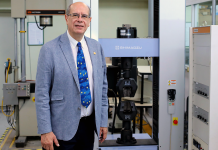
You’re the lead author on the report, “Thermal Batteries: Decarbonizing U.S. Industry While Supporting A High-Renewables Grid.” What is your background, and what were your key findings?
I’m the senior director of the industry program at Energy Innovation. We’re a nonpartisan clean energy and climate think tank that looks at technologies that can affordably reduce greenhouse gas emissions and promote industry. My report on thermal batteries is a work that I and one co-author, Eric Gimon, did on a new and emerging technology for industrial heating.
Thermal batteries are essentially a way to store thermal energy or heat. They charge using electric resistance and then they discharge by pumping a gas through the storage medium, which is graphite bricks or silicon dioxide sand. The gas absorbs heat from the hot storage medium and then is pumped into an industrial facility where it’s used to heat equipment, parts, and materials for processing. Thermal batteries can operate either grid-connected or off-grid.
One key finding of the study was on cost reductions. We found these thermal batteries, inclusive of all costs (so, including their capital costs, levelized over their lifetime, and the energy costs), they can output heat in the locations we studied at $35 to $62 per megawatt-hour thermal, which is roughly one-half to one-third the cost of buying electricity from the grid and is broadly competitive with natural gas pricing. The biggest hurdle to electrifying heat is cost, and this is a technology that can help.
What drove the need to focus emissions challenges to industries other than power and transportation?
Industry is extremely important and has been somewhat overlooked in the past. The industrial sector, or manufacturing, is responsible for about a quarter of the world’s greenhouse gas emissions directly. And if you count electricity and steam purchased by industry, it’s responsible for about a third. So, if industry is responsible for a quarter or a third of all human emissions, you need to address industry in order to achieve our climate goals and stabilize Earth’s climate.
What processes are the most challenging for the heat-treating industry?
Thermal batteries usually are delivering their output in the form of a hot gas. Anything that accepts bulk heat without fine precision is a good fit, like heating a furnace or if you want to treat an entire part, like you’re tempering or annealing the entire part. There are other electrical solutions like plasma torches, plasma cutters, or lasers that are excellent at applying heat precisely.
How can your research benefit heat treaters as they look toward the future?
A transition to clean and modern industry is underway and is going to be increasingly important for businesses going forward as policymakers and purchasers of industrial products start to pay attention to the need to decarbonize industry and the need for clean industrial processes. A lot of these technologies haven’t been pursued as much in the past, so they’re still early in their learning curves, but we’ll have cost declines in the future. This is meshing nicely with a policy environment that is increasingly valuing clean production.
For instance, Europe is implementing a Carbon Border Adjustment Mechanism where they’re going to be looking at the emissions that went into making certain products. It’s the efficiency not of the product itself, but of the process that was used to make the product. If emissions were too high, there will be a tax on the product in order to sell it in the European market. That’s a large market, and that’s just a start. There are other proposals elsewhere for policies that incentivize clean production — both carrots and sticks. One reason our work has value for industry and for the heat-treating industry is it helps point out these opportunities.
What kinds of technology will be needed to help smooth this transition to decreasing emissions?
There are a wide range of electrical technologies that can provide industrial heating. Thermal batteries are just one. There’s electrical resistance heating. There’s dielectric heating. I’ve already mentioned lasers, plasma torches, and plasma cutters. There’s also electromagnetic induction and infrared.
Those are just a few technologies that can power industrial processes and deliver heat from electricity.
After addressing these emissions challenges, where do you see the heat-treating industry in the next 10 years?
I think the heat-treating industry is going to be using more electrified processes. It will be more common because the electrified technologies will be more cost-effective. In the U.S., there are federal programs helping with this transition, and they present some great opportunities. The Department of Energy’s Industrial Efficiency & Decarbonization Office, the Office of Clean Energy Demonstrations, and the Loan Programs Office all have programs to provide money to help with adoption of new technologies. Certain provisions are in the Inflation Reduction Act also provide support, including the Advanced Energy Project Credit, the Advanced Industrial Facilities Deployment Program, and for firms producing certain energy-related products, the Advanced Manufacturing Production Credit.
Is there anything else you’d like to mention that we didn’t discuss?
I have a book coming out in January. The book is called “Zero-Carbon Industry,” and it’s being published by Columbia University Press. It provides a deep dive into the top energy-using industries, covers a wide range of technologies that will be important to a clean industrial transition, and highlights policy approaches that can incentivize new technologies and how manufacturers can take advantage of them.
MORE INFO energyinnovation.org


























